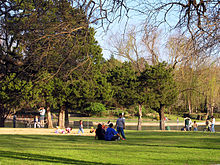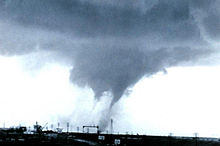- Climate of Dallas
-
This article is part of a series on:
The City of DallasTerritorial (-1838) Settlement (1839-1855) Early Existence (1856-1873) Industrial Period (1874-1929) Oil Period (1930-1945) Mid Century (1946-1974) Real Estate Boom (1975-1985) Recession (1986-1995) Modern Period (1996-) - Law and government
- Culture
- Climate
- Demographics
- Education
- Transportation
The city of Dallas has a humid, hot climate and is often prone to storms ( severe or not) (Koppen climate classification Cfa), though it is located in a region that also tends to receive warm, dry winds from the north and west in the summer, bringing temperatures about 102 °F (39 °C) at times and heat-humidity indexes soaring to as high as 117 °F (47 °C).
A couple of times each year, warm and humid air from the south overrides cold, dry air, leading to freezing rain, which often causes major disruptions in the city if the roads and highways become slick. On the other hand, daytime highs above 65 °F (18 °C) are not unusual during the winter season. In sum, extremes in weather are more readily seen in Dallas and Texas as a whole than along the Pacific and Atlantic coasts, due to the state's location in the interior of the United States.
Spring and autumn bring pleasant weather to the area. Vibrant wildflowers (such as the bluebonnet, Indian paintbrush and other flora) bloom in spring and are planted around the highways throughout Texas.[1] Springtime weather can be quite volatile, but temperatures themselves are mild. The weather in Dallas is also generally pleasant between late September and early December, and unlike springtime, major storms rarely form in the area.
In the spring, cool fronts moving south from Canada collide with warm, humid air streaming in from the Gulf Coast. When these fronts meet over north central Texas, severe thunderstorms are generated with spectacular lightning shows, torrents of rain, hail, and occasionally, tornadoes. Over time, tornadoes have perhaps been the biggest natural threat to the city.
The U.S. Department of Agriculture places Dallas in Plant Hardiness Zone 8a.[2][3] According to the American Lung Association, Dallas has the 12th highest ozone air pollution in the nation, ranking it behind Los Angeles and Houston.[4] 30% of the air pollution in Dallas, and the Metroplex in general, comes from the three cement plants in the town of Midlothian, as well concrete installations in neighboring Ellis County,[5] but the foremost contributor to air pollution in Dallas is exhaust from automobiles. Due to the area's spread-out nature and high amount of urban sprawl, automobiles are the only viable mode of transportation for many residents in the metropolitan area.
The city's all-time recorded high temperature is 113 °F (45 °C), while the all-time recorded low is −8 °F (−22 °C). The average daily low in Dallas is 55.0 °F (12.8 °C) and the average daily high in Dallas is 76.3 °F (24.6 °C).[6] Dallas receives approximately 34.7 inches (881 mm) of equivalent rain per year.
Contents
Volatile weather
Tornadoes
A multiple-vortex tornado outside of Dallas, Texas on April 2, 1957.
Since Dallas lies at the lower end of the "Tornado Alley", tornadoes are perhaps the biggest threat to the city. Dallas was hit by a powerful tornado on 2 April 1957. The tornado would have likely been an F3.[7] On March 28, 2000, the “Fort Worth Tornado” impacted Dallas's neighbor Fort Worth's downtown, and a tornado in Arlington, Texas also occurred that day damaging some homes. That day was the Metroplex's most damaging tornado outbreak since the 1957 event.
Floods
Major flooding occurred on the Trinity River in the years 1844, 1866, 1871, and 1890, but a major event in the spring of 1908 set in motion the harnessing of the river. On 26 May 1908, the Trinity River reached a depth of 52.6 feet (16.03 m) and a width of 1.5 miles (2.4 km).[8] Five people died, 4,000 were left homeless, and property damages were estimated at $2.5 million.
“ Now the wreckage of a shed or outhouse would move by, followed by a drowned swine or other livestock. The construction forces of the Texas & Pacific worked feverishly to safeguard the long trestle carrying their tracks across the stream. Suddenly this whole structure turned on its side down-stream, broke loose from the rest of the track at one end and swung out into the middle of the current and began breaking up, first into large sections and then into smaller pieces, rushing madly along to some uncertain destination. [Approximately half a dozen of the workmen fell into the torrent at this point; exaggerated reports of their drowning swept the city.] ” —C.L. Moss, [8]
Dallas was without power for three days, all telephone and telegraph service was down, and rail service was canceled. The only way to reach Oak Cliff was by boat.[9] West Dallas was hit harder than any other part of the city—the Dallas Times Herald said "indescribable suffering" plagued the area. Much to the horror of residents, thousands of livestock drowned in the flood and some became lodged in the tops of trees—the stench of their decay hung over the city as the water subsided.[8]
After the disastrous flood, the city wanted to find a way to control the reckless Trinity and to build a bridge linking Oak Cliff and Dallas. The immediate reaction was citizens and the city clamoring to build an indestructible, all-weather crossing over the Trinity. This had already been tried following the 1890 flood—the result was the "Long Wooden Bridge" that connected Jefferson Boulevard in Oak Cliff and Cadiz in Dallas, but the resulting unstable bridge was easily washed away by the 1908 flood. George B. Dealey, publisher of the Dallas Morning News, proposed a 1.5 miles (2.4 km) concrete bridge based on a bridge crossing the Missouri River in Kansas City. Ultimately a US$650,000 bond election was approved and in 1912, the Oak Cliff viaduct (now the Houston Street viaduct) was opened among festivities drawing 58,000 spectators. The bridge, at the time, was the longest concrete structure in the world.[8]
Historical averages
Template:Allen TX weatherbox
References
- ^ TXDOT - Wildflower and Fall Foliage. Retrieved on 17 April 2007.
- ^ "Texas USDA Hardiness Zone Map". http://www.plantmaps.com/interactive-texas-usda-plant-zone-hardiness-map.php. Retrieved 2010-11-28.
- ^ USNA - USDA Plant Hardiness Zone Map: South-Midwest US. Retrieved on 13 June 2006.
- ^ Lungusa.com. Retrieved on 2 March 2006.
- ^ Downwindersatrisk.org - Pollution in Midlothian. Retrieved on 17 April 2006.
- ^ "Dallas/Fort Worth - Normal, Means, and Extremes". National Weather Service Fort Worth. http://www.srh.noaa.gov/fwd/?n=dfwann. Retrieved 17 April 2010.
- ^ Stormtrack.org - APRIL 2, 1957: DALLAS'S DATE WITH DISASTER. Retrieved on 17 April 2006.
- ^ a b c d Payne, Darwin (1982). "Chapter V: A New Century, A New Dallas". Dallas, an illustrated history. Woodland Hills, California: Windsor Publications. pp. 119–155. ISBN 0-89781-034-1.
- ^ Dallas Historical Society - Dallas History. Retrieved 20 April 2006.
Categories:- Dallas, Texas
- Climate by city
- Climate of Texas
Wikimedia Foundation. 2010.



